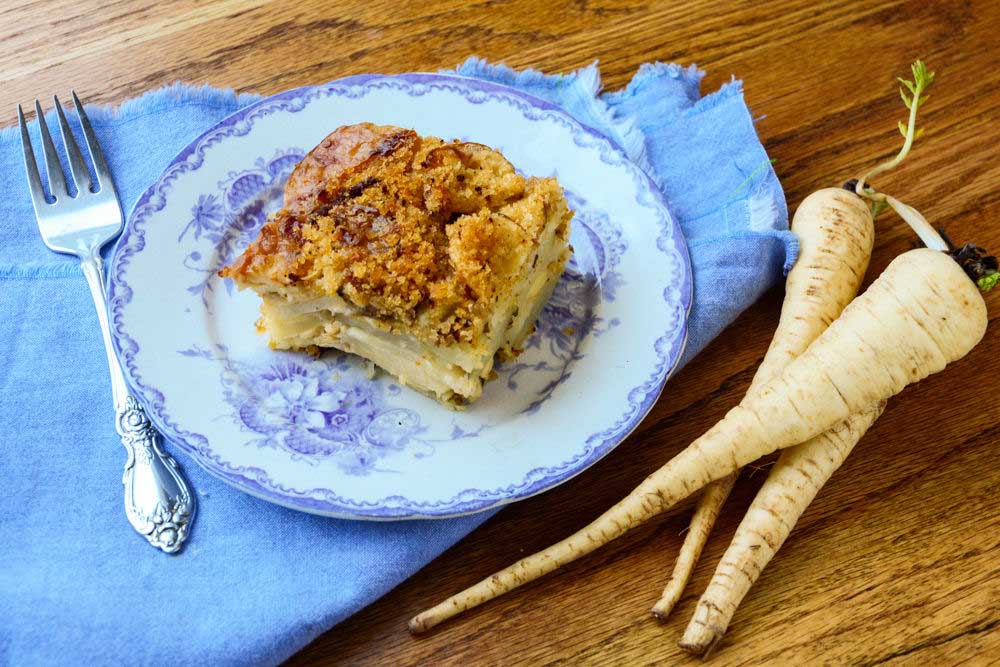The County Cookery Parsnips au Gratin
Published 6:00 am Wednesday, January 15, 2020

- Parships au Gratin adds parsnips and some extra zip to the whole concept of potatoes au Gratin.
Parsnips au Gratin
What I love about this recipe most is the combination of flavors between Swiss cheese and the parsnips and cream. You’ve got what heaven must taste like! A ham dish would be nice, or even a turkey.
Trending
—Deb Reth, Wallowa
1 cup breadcrumbs
2½ cups grated Swiss cheese
3 tablespoons butter, melted and cooled
3 cups heavy cream
1¼ teaspoons salt
Trending
1 teaspoon black pepper
4 medium Russet potatoes, scrubbed and thinly sliced
2 cups grated parmesan cheese
6 medium parsnips, scrubbed, trimmed and thinly sliced
Preheat the oven to 375 degrees and line a baking sheet with parchment paper or foil.
Combine the breadcrumbs with ½ cup Swiss cheese and the butter in a bowl and set aside. Whisk the cream, salt and pepper in a measuring cup. Arrange half of the potatoes in a greased 9-by-13-inch baking dish. Pour 1 cup of the cream over them and sprinkle with 1 cup of the Swiss cheese and 1 cup of the parmesan cheese. Arrange half of the parsnips over the cheese, then repeat the layers once more, ending with the last cup of cream. Sprinkle the breadcrumbs evenly over the top.
Cover with foil and place on the prepared baking sheet to catch drips. Bake until the vegetables are tender, 65-75 minutes. Uncover and bake until golden brown and bubbling, about 15 minutes more.
INTERVIEW with Deb Reth
What does a parsnip taste like?
It’s a member of the carrot family. So the closest thing I can say is it would be like a white carrot, but not as tender. It’s not like you want to just chomp into a raw parsnip. Although I had kids in my youth group at church, they wanted raw parsnips.
Parsnip is a vegetable that should be grown by anybody in the cold country. You’ve got to get it planted usually in March or April. The instructions with the seeds say, “As soon as the ground can be worked.” It takes a month to germinate.
Why do you love root vegetables?
I think that just comes from my Eastern European ancestry. I love food that you grow in the summer and you’re eating in December and January and sometimes even April. The things that get you through until the greens start to grow. These roots are so important and we should learn how to store them.
How do you store root vegetables?
Well, textbook thing is in sand or in saw dust. I don’t get around to that a lot of times. Mine just sort of sit in burlap sacks where they can breathe, and that’s maybe part of the reason why the skins will oxidize a little bit. Sand keeps the oxygen away from the roots. For carrots and parsnips, it’s ideal to keep them in the ground all winter if you don’t have a rodent problem.
Why do you leave the skins on the potatoes and parsnips?
If we know that they’re organic or unsprayed then we don’t need to peel any of our fruits or vegetables. They’ve got as much, if not more, vitamins and minerals, in the skin. That’s their defense mechanism against the soil-born bacteria and funguses. So, it just makes sense to get as much out of our produce as we possibly can by not peeling them. I mean, we have to peel a few things. I was making apple pies last night and I got hit by codling moths this year. A lot of people got their apple trees hit pretty hard this year. But I would rather carve around the ugly spots.
Editor’s note: Do you have a special recipe for a dish made with local food? Contact Slow Food Wallowas, slowfoodwc@gmail.com for more information. Your recipe may appear in a future column.









